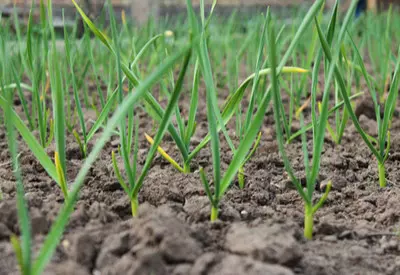This past weekend, it was time for the garlic harvest in our garden. If there is one single crop that we look forward to harvesting more than almost any other, it is our fall-planted, hardneck garlic.
There are two main types of garlic, softneck and hardneck. In general terms, softneck garlic can be grown in climates with more mild winters.
Hardneck on the other hand, grows best in areas where winters are long and cold. With both varieties, you can plant and harvest garlic in the same season, but fall planting and over-wintering the crop results in larger and more robust heads.
Seed Links : Hardneck Garlic Seed, Softneck Garlic Seed

The Garlic Harvest – Garlic curing after being harvested
One additional benefit of hardneck garlic is that they grow tasty garlic scapes in addition to the heads.
Scapes are long-stemmed shoots that form in early spring and are highly prized by chefs the world around. They are a mild mini-version of the garlic that will be harvested a few months later.
For our climate in Ohio, we have always planted and loved hardneck garlic. It can be planted in early to mid-September and then over-wintered for a summer harvest.
Planting in September allows just enough time for the garlic to sprout and begin to develop before going dormant through the cold winter months. See : How To Plant Garlic and Onions In The Fall
When spring approaches,the garlic once again takes off. It forms its tasty garlic scapes in late spring. By late June or early July, the tops begin to brown off and the garlic harvest is on!
The Garlic Harvest – When And How To Harvest
Garlic should be harvested when the soil is more on the dry side. If the soil is too moist or water-logged, the garlic can become caked in dirt and mud.
A clean, dry harvest means that the skin of the bulbs remains in tact. This protects the garlic while it cures. If over-saturated, the wet soil clings to the garlic heads, and can become problematic to remove without damaging the skins.

Garlic sprouting up in early fall
You know your garlic is ready to harvest when about two-thirds of the stock above the soil line have turned brown.
Harvesting
Harvesting is a simple process. The main objective is to make sure the bulbs are not damaged while being unearthed.
Place a shovel or pitchfork approximately 4 inches behind the stalk. Carefully sink your digging tool down 4 to 6 inches under each stock, and lift slowly to unearth the bulbs. Do not pull on the stalks, as this could easily damage the bulbs below.
Gently brush any remaining soil from around the garlic bulb. Be careful not to damage any of the cloves or stems, leaving the papery outside of the bulb in tact.
Damaging the outer layers of the garlic before it has a chance to cure can lead bulbs to prematurely rot. If there is a little stubborn moist dirt left on bulbs, allow it to remain. It will be easy to brush off later as it dries.
Curing Garlic
Before you store the garlic, you need to cure it for a few weeks. Curing is the process of hardening off the garlic.
To cure garlic, hang in a dry area that is out of direct sunlight. It can be somewhat warm, but avoid areas of extreme heat. The more airflow that is present, the better.
We have always used our barn rafters to cure our garlic harvest. We hang the long stems from a few of the lower rafters with a bit of twine.
Within a few weeks, they are cured and ready for storage. Bulbs are ready to store as soon as they have dried to the touch and become hardened on the outside.
You can use the garlic at any time, including right after harvest. But to keep for long-term use, curing is a must.
Storing Garlic
Once the garlic has cured, snip the remaining stalk about 1 inch, to 1.5 inches above the garlic head. The stalks are great to place into the compost pile.
Store the garlic heads in a cool, dark, dry location for maximum storage time. We have always been able to store our garlic for an entire year, until the next harvest.
Select The Best Garlic For Planting This Fall
Once our garlic has been cured and stored, we pick out the best bulbs for planting in the fall. Garlic, as it becomes accustomed to local soil conditions, grows better each year. Select the best and healthiest of this year’s harvest to plant as seed.
Each clove in a garlic head is seed, so you can get 10 to 12 seeds per head. Keep the clove heads together until planting time.
Here is to growing and harvesting your own crop of garlic! Jim and Mary
To receive our 3 Home, Garden, Recipe and Simple Life articles each week, sign up below for our free email list. You can also follow us on Facebook, Twitter, Pinterest, or Instagram. This article may contain affiliate links.
